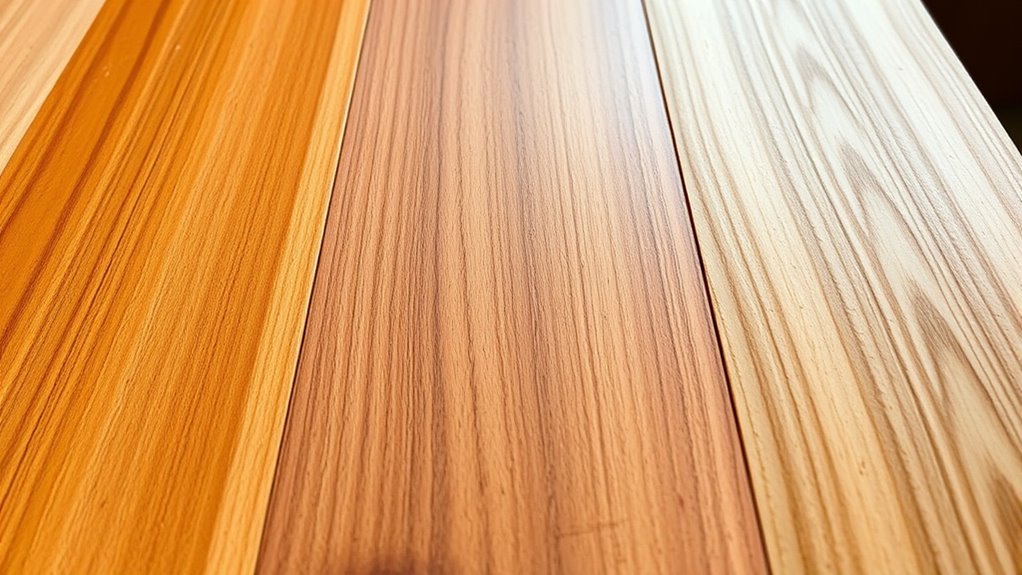To care for your butcher block countertop, choose between oil, varnish, or wax depending on your needs. Oil penetrates deeply, offers moisture resistance, and is easy to reapply for a natural look. Varnish creates a tough, durable surface but may alter the wood’s appearance and needs periodic maintenance. Wax provides a soft sheen with light water resistance but isn’t suitable for heavy use. Continue exploring to find the best routine for your countertop.
Key Takeaways
- Oil penetrates deeply, enhances natural look, and requires regular reapplication for moisture protection.
- Varnish creates a durable, hard surface, needing less frequent reapplication but may alter wood appearance.
- Wax offers a soft sheen and slight water resistance, suitable for light-use counters but less protective overall.
- Proper maintenance includes cleaning with mild soap, drying thoroughly, and periodic sanitizing regardless of finish.
- Choose based on desired durability, appearance, and maintenance effort: oil for natural look, varnish for toughness, wax for decorative use.

Are you wondering how to keep your butcher block countertop looking its best? The key lies in understanding proper maintenance routines and choosing the right protective finish based on material comparisons. Your goal is to preserve its beauty while ensuring durability, and that starts with knowing which finish suits your needs.
Maintaining your butcher block depends on proper care and choosing the right finish for durability and beauty.
When it comes to maintenance routines, regular upkeep is essential. You should clean your butcher block daily with a damp cloth and mild soap, avoiding excess water that can cause warping or swelling. After cleaning, drying thoroughly prevents moisture from seeping into the wood. Periodically, you’ll want to sanitize the surface with vinegar or a food-safe disinfectant, especially after handling raw meat or poultry. Applying a protective oil regularly keeps the wood hydrated and helps prevent cracking. How often you oil depends on usage; generally, once a month is sufficient for most households. For high-traffic counters, more frequent applications may be necessary.
Material comparisons are vital when selecting a finish. Oil, varnish, and wax each have distinct advantages and drawbacks. Oil finishes, such as mineral oil or beeswax, penetrate deeply into the wood, enhancing its natural beauty and providing a moisture barrier. They’re easy to apply, affordable, and revitalize the surface with simple reapplications. However, oil finishes require consistent maintenance—re-oiling every few weeks or months—to keep the surface protected. Varnish, on the other hand, forms a hard, protective surface on top of the wood. It offers excellent durability and resistance to stains and scratches, making it suitable if you want a low-maintenance option. But varnish can alter the natural look of the wood and may crack or chip over time, demanding periodic reapplication or touch-ups.
Wax finishes provide a smooth, polished look and a slight water resistance. They’re easy to apply and give your butcher block a soft sheen, but they’re less protective against moisture and heavy use. You’ll need to re-wax periodically, especially after cleaning with harsh chemicals or frequent use. When comparing these materials, think about your lifestyle: if you prefer a natural look with simple upkeep, oil is your best choice. If you want maximum durability with less frequent maintenance, varnish might suit you better. Wax could be ideal for decorative purposes or light-use counters.
Frequently Asked Questions
How Often Should I Reapply the Chosen Finish on My Butcher Block?
You should reapply your chosen finish every 3 to 6 months for ideal maintenance, depending on usage and the finish’s durability. Regularly check your butcher block for signs of dryness or wear. Oiling needs more frequent attention, while varnish or wax may last longer before needing reapplication. Keeping a consistent maintenance schedule helps protect the wood and keeps your countertop looking great.
Can I Use Household Cleaning Products on My Butcher Block Countertop?
Think of your butcher block as a delicate garden needing gentle plants. Household cleaners are like harsh chemicals that can damage your plants, so avoid them. Instead, use mild soap and water to clean your counter. This guarantees chemical safety and keeps your surface in great shape. Using strong household cleaners can strip oils or finishes, so stick with gentle options to preserve your butcher block’s beauty and durability.
Is It Safe to Cut Directly on a Finished Butcher Block Surface?
You can cut directly on a finished butcher block surface, but keep in mind that it may influence cutting safety and finish durability. While the finish provides some protection, it isn’t completely resistant to scratches and cuts from knives. For the best results, use a cutting board to preserve the surface’s integrity and ensure safety. Regularly maintain the finish to keep your countertop looking good and functioning well over time.
How Do I Remove Stains or Deep Scratches From My Butcher Block?
Stains or deep scratches? You can handle them like a pro! Start by applying a mixture of baking soda and water for stain removal, gently scrubbing with a soft cloth. For deep scratches, sand the area with fine-grit sandpaper, then re-oil or re-varnish to restore beauty. Regular maintenance keeps your butcher block looking pristine, and quick action prevents minor blemishes from becoming permanent damage.
What Are the Signs That My Butcher Block Needs Refinishing or Resealing?
You’ll notice your butcher block needs resealing when the wood grain patterns become dull or stained despite cleaning. If water no longer beads on the surface or absorbs quickly, it’s a sign to refresh the sealing techniques. Additionally, deep scratches or stains that resist removal indicate it’s time to reapply oil, varnish, or wax to maintain protection and appearance. Regular resealing keeps your countertop looking its best.
Conclusion
Now that you know the differences between oil, varnish, and wax, your butcher block is ready for a new level of care. But which finish will truly stand the test of time? The choice isn’t just about protection — it’s about preserving your countertop’s beauty and functionality for years to come. Stay tuned, because the decision you make today could transform your space in ways you never expected. Are you prepared to reveal its full potential?









